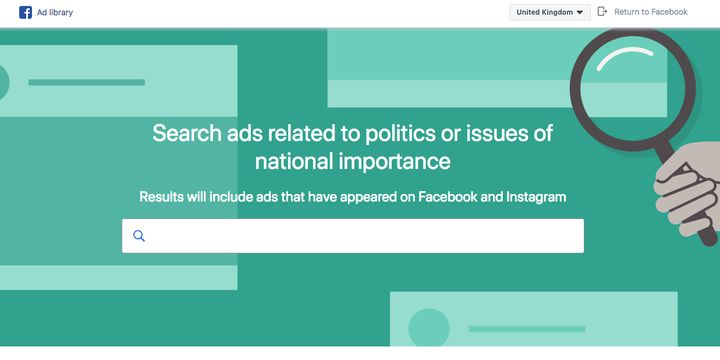
In a bid to improve transparency around political advertising, Facebook has launched a new tool which people can use to check up on the groups and organisations putting paid posts on their timelines.
The Ad Library lets anyone – regardless of whether they’re a Facebook user – view and search for ads related to politics or “issues of national importance” that have been on Facebook and Instagram.
The service has been available for months in the US and Brazil, and as of today (Tuesday 16 October) users here in the UK can see when groups – such as political parties or media organisation – paid for posts, how much they spent and who they were targeted at.
Anyone using the tool will also be able to see which ads breached Facebook rules by not being labelled as paid posts and which ones were disapproved after being shared.
How Could This Be Useful?
As the library only just launched, a UK-based search through it doesn’t really reveal any particularly enlightening info. Here are the result for searches for UK ads that mentioned Theresa May:

So yeah, there’s nothing to look at right now. This is because the library only launched this morning but from today onwards, any promoted post that mentions the prime minister will appear here.
Here’s what it looks like if you search for US adverts that mention Donald Trump:

Yes, that’s 330,000 results in the five months since the library launched. The list shows any ad that has mentioned the current president, so the list includes both pro-Trump posts and ones from political rivals, mixed in with ones selling merchandise and adverts from news organisations.
When you click a post, you can view more information on it. Take this one from the Democrats:

Anyone can see that the ad started running on 15 October and has so far had between 1,000 and 5,000 “impressions” – that just means the number of timelines it’s been shown on – and a total spend of less than $100, paid for by the page itself.
Further down, the sidebar reveals the demographic of people who have seen it, which hints at who the party’s social media experts were trying to target.
In this case, the post has been viewed by more women than men, with the 45-54 age group being targeted.
There’s also a geographical breakdown, which reveals most people who saw the ad on their timelines were based in North Carolina, Florida and Arkansas – three key states in the upcoming midterms.
Why Is This Important?
It could give groups and organisations an insight into what their rivals are doing. In the case of the Democrats’ ad above, it hints which areas they think they could win in and who they want to sway.
But it’s also useful for individuals, who can work out why they might be seeing a promoted post – which could good to know next time there’s an election or referendum that leads to an increase of political ads on timelines.
You can also search for adverts paid for by certain pages – for instance, those belonging to political parties, individuals or media outlets – and have a snoop at how much cash they’re spending on ads.
The company had said the new tool is part of a commitment it made during appearances before the Department for Digital, Culture, Media and Sport (DCMS) earlier this year.
It comes after the platform was scrutinised for its policies towards advertising, as questions had been raised over the use of online ads, particularly around the last US presidential election and the EU referendum in the UK.
